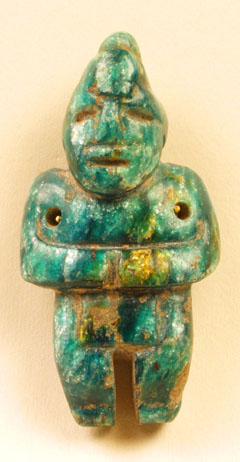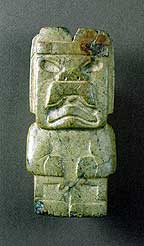Emerald Man
A research project conducted by former Hudson Museum Director Stephen Whittington with James Vose, and Charles Hess
 A small stone object, identified by the catalog number HM601, is part of the permanent collection of the Hudson Museum. It was bequeathed to The University of Maine in 1982 by alumnus William P. Palmer III, along with more than 2000 other objects, the majority from Mesoamerica. An index card that came with the artifact and is maintained in the object file states:
A small stone object, identified by the catalog number HM601, is part of the permanent collection of the Hudson Museum. It was bequeathed to The University of Maine in 1982 by alumnus William P. Palmer III, along with more than 2000 other objects, the majority from Mesoamerica. An index card that came with the artifact and is maintained in the object file states:
Emerald figure of a man. To the best of my knowledge the only Emerald carved in the round piece in existence of Pre-Columbian origin. Area unknown. 500 BC to AD 200.
It is unclear who wrote the original record which also indicates the piece is Olmec, was purchased or delivered on March 30, 1968 and was originally numbered 284M. Palmer bought objects numbered in this way from a New York City art dealer. The object file also contains a copy of a flyer indicating that this object and seven others were stolen from Palmer sometime between October 16 and 18, 1968. It is not known when or how the pieces were recovered and returned to him.
The stone figure (pictured on the left) is emerald green in color with many small areas of blackish-green and yellow mottling. The lapidary who created it used straight cuts to carve it into the shape of a standing man. The man’s hands are folded over his mid-section and he wears a short apron and headgear. Drilled holes pass through the figure under the arm pits and from side to side through the head. The figure is 5.63 cm high, 2.85 cm wide and 1.37 cm thick. Its weight is 23.7 g or 118.5 carats.
Is it a natural emerald?
Beryls are aluminum beryllium silicate, or Al 2 Be 3 (Si 6 O 18 ), and come in various colors The ones that are distinctive emerald green in color are considered most valuable. “Emerald” is derived from a Persian word which appeared in Greek as smaragdos , meaning “green stone.” Replacement of beryllium by alkali oxides and aluminum by chromic or ferric oxides in emeralds is common. The distinctive green color of emeralds is caused by trace amounts of chromium or vanadium. The following tests were performed by certified gemologist James Vose to determine if HM601 is a natural emerald:
Test 1: Visual and microscopic (50x) examination.
The overall appearance and color are consistent with a natural emerald, rather than an epoxy fake. Genuine emeralds are often clouded by inclusions (known as “jardin” ) and show an irregular distribution of color.
Test 2: Determination of refractive index (R.I.).
This is the most valuable gem-testing procedure to perform. The R.I. is the ratio of the velocity of light in air to its velocity in a given substance. The “spot method” was used to determine the approximate R.I. because of the figure’s rounded surfaces. To produce an optical contact between the figure and the glass hemisphere of the refractometer instrument, a minute dot of methylene iodide with tetraiodoethyl added was used on the surface of the figure. The figure’s R.I. is within the 1.577-1.583 range of natural emerald.
Test 3: Chelsea filter test
The Chelsea or emerald filter is used to distinguish emerald from other green stones and imitations. The filter absorbs most of the visible light spectrum but transmits the long red wavelengths and a band in the yellow-green portion of the spectrum. Emerald transmits red light and absorbs some yellow-green light, so it appears red when illuminated by bright incandescent light and viewed through the filter. Most other green stones and glass imitations appear green. However, a few other green stones and synthetic emeralds appear red, while emeralds from some localities appear green when viewed through the filter. A high-intensity fiber optic cold light source was used to examine numerous areas of the figure. A definite reddish area appears at the edge of the right shoulder, consistent with natural emerald from Colombia or Russia.
Test 4: Determination of specific gravity (G).
G is the weight of a substance compared to the weight of an equal volume of pure water, expressed in terms of g/cm 3 . The hydrostatic method is the best way of obtaining accurate results on large specimens. Using a diamond balance, the figure was weighed in air, then in water. Specific gravity was calculated according to the formula:
G= wt. of figure in air/(wt. of figure in air-wt. of figure in water).
Final determination of G was 2.887. This is an exceptional result for an emerald, since the normal range is 2.670-2.780, but it is within the 2.800-2.910 range of alkali beryls. No emeralds reported in the literature have such a high value of G. However, alkali beryls do not have the green color of emeralds.
Test 5: Absorption spectroscopy.
Attempts to obtain a spectrum by using a hand spectroscope on light from a fiber optic source passed through and reflected off the surface of the figure failed.
Test 6: Observation under ultraviolet (UV) light.
Luminescence is emission of light without application of strong heating. Under long-wave UV light, emerald specimens from most localities show very weak florescence or none at all, but some show a strong red. Emeralds from Chivor, Colombia display a very weak red glow. Synthetic emeralds fluoresce dark or strong, dull red. Under long-wave UV light, the figure showed purplish-red in the waist area and below on the front and from the shoulders to the legs on the back. Under shortwave UV light, 98% of the surface was purplish-red, with a brighter red area on the back of the head.
What is the source of the raw material?
Emeralds come from only a few localities around the world. Most emeralds occur in metamorphic rocks as a by-product of that environment but Colombian deposits are unique because they are based on hydrothermal processes. Physical characteristics of emeralds, including color, transparency, inclusions, trace elements, specific gravity, refractive index, appearance through the Chelsea filter and florescence under UV light vary depending on locality. The rarity of emerald sources is apparent on a map of origins of emeralds around the world.
During the Conquest, Pizarro and Cortes sent emeralds from Peru and Mexico, respectively, to the Spanish court. Cortes obtained his emeralds from the Aztec capital of Tenochtitlan. The only source of the stone in the Western Hemisphere known at the time of the Conquest was Colombia. Emeralds reached as far south as Bolivia and as far north as Mexico by trade. It is known that the Colombian sources were being mined by the Chibcha earlier than AD 1000, but how much earlier is unknown.
Test 7: Spectral analysis by scanning electron microscopy (SEM). The emerald was placed in a vacuum in an ElectroScan environmental SEM made by Noran Instruments, Inc. to run energy dispersive X-ray tests on three locations. Tiina Hallamaa, a visiting scientist from the Finnish Pulp and Paper Institute, ran the equipment under the supervision of Pierre Lapoutre, professor of Chemical Engineering, in a Paper Surface Science Program laboratory at The University of Maine. The SEM column in Table 1 includes elements from Figure 1 and Figure 2 but not Figure 3, because of possible contamination.
Test 8: Trace element analysis by X-ray fluorescence (XRF) . The trace elements in a sample can be of aid in evaluating gem stones. Using a New England Nuclear Cd-109 source of silver X-rays (25KeV) and a Canberra intrinsic germanium X-ray detector with a Canberra amplifier and a high voltage supply, and an Oxford-Nucleus PCA Board in 486-66 personal computer, Charles T. Hess and N. Nation of the Department of Physics and Astronomy at The University of Maine collected data for 708 seconds elapsed time, 2259 seconds real time. Calibration was done using an X-ray fluorescence sample of copper and the silver source X-rays. The resulting spectrum is shown as Figure 4. The “XRF” column in Table 1 includes elements from Figure 4.
To read more about the Emerald Man, visit the news briefs at Archaeology magazine.
Is it Olmec?
The figure’s general appearance is similar to some small Olmec stone figures but it lacks certain defining characteristics which would make identification certain. For example, it does not possess the cleft forehead and down-turned mouth typical of many Olmec carvings (see below). The holes drilled under the armpits are common features of many Mesoamerican stone and ceramic figurines.
 Stone Were-Jaguar Baby pendant combining feline and human traits. Has typical V-shaped forehead indentation and baby face whose features include a mouth with down-turned corners in a snarl or cry, prominent upper lip, toothless gums and flat nose.
Stone Were-Jaguar Baby pendant combining feline and human traits. Has typical V-shaped forehead indentation and baby face whose features include a mouth with down-turned corners in a snarl or cry, prominent upper lip, toothless gums and flat nose.
Test 9: Microscopic examination.
James Vose and Stephen Whittington examined the figure under the magnification of a light microscope. The drilled holes are wider near the surface than in the interior. Marks above the cut defining the top of the left hand and on the left thigh adjacent to the gap between the legs indicate that the cutting tool slipped during the cutting process. Both characteristics suggest that hand tools, rather than power tools, were used. The fact that the errors were not polished away means that magnification was not being used.
Where was it dug up?
A call was made to the art dealer who sold the figure to Palmer to ask if he had any information about the history of the figure before Palmer bought it, especially the site from which the object was dug, presumably by pot-hunters. The dealer was not forthcoming with information.
Conclusions
Is it a natural emerald?
The material appears to be natural emerald, despite its exceptional specific gravity. G is directly related to the amount of alkali oxides in the stone and X-ray fluorescence indicates the presence of a large amount of strontium and smaller amounts of rubidium and barium. All of these elements form oxides with molecular weights much higher than that of beryllium oxide, which they replace in the structure of the emerald. This could account for the value of G. The red glow under long-wave UV light could signal that this is a synthetic emerald, if not for the large number of trace elements, which are unlikely to appear in synthetics.
What is the source of the raw material?
If emerald-bearing shales are considered, the best match for the figure is the Muzo source in Colombia. However, X-ray fluorescence uncovered strontium and bromine in the emerald, which do not match any published source. Therefore, the source may still be undiscovered. One tantalizing possibility is a rumored source in the jungles of eastern Ecuador.
Is it Olmec?
Uncorrected errors made by the lapidary and conical drill holes suggest a Precolumbian origin, but lack of definite Olmec characteristics preclude assigning it to that culture.
Where was it dug up?
This information appears to be unobtainable, unless soil remaining within cuts can someday be chemically matched with soil at a particular site.
